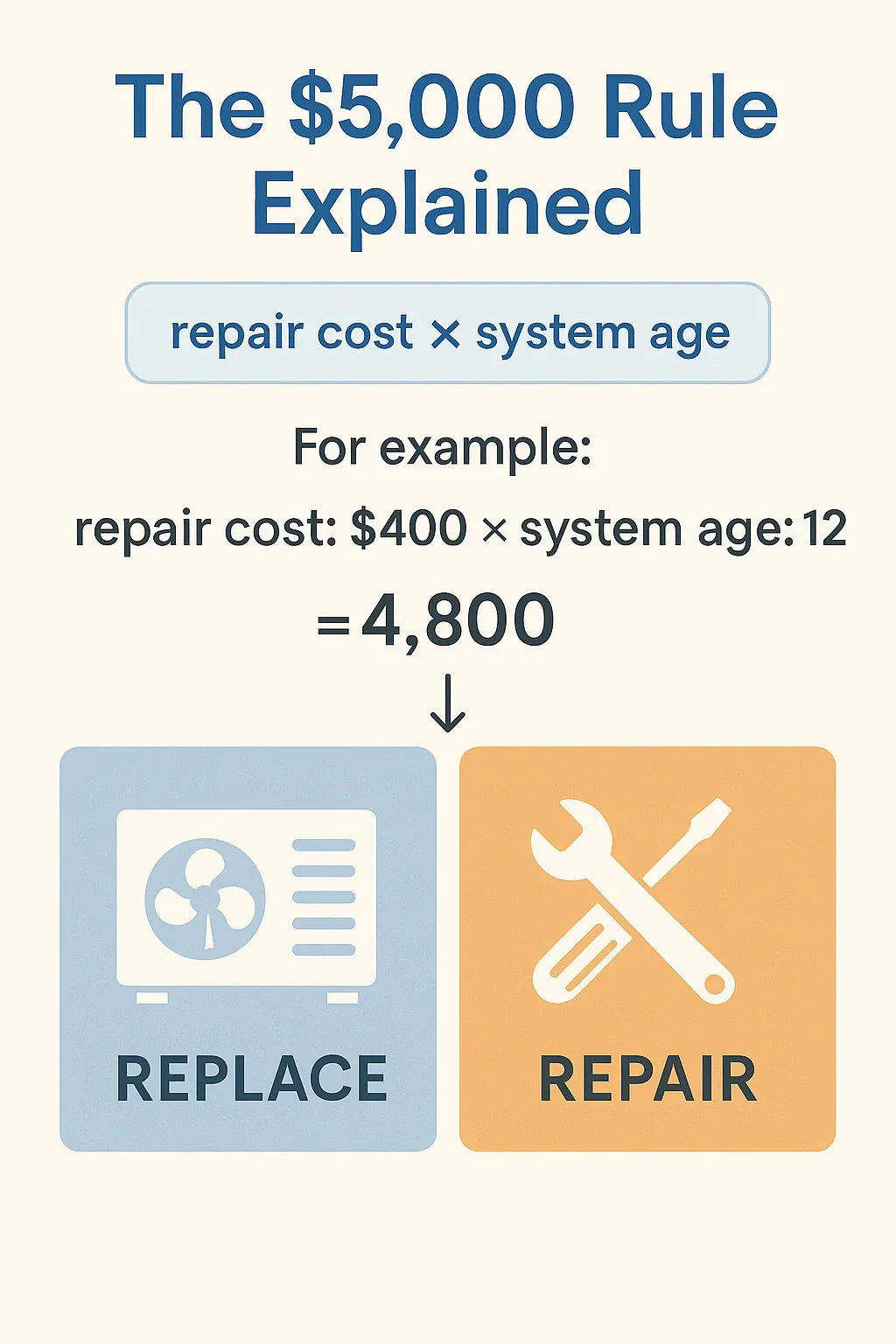By Alex Lane | Your Home Comfort Advocate
So your HVAC system is acting up again—and now you’re wondering: “Do I fix it one more time, or is it finally time to replace the whole thing?” You're not alone.
This is one of the most common (and stressful) questions homeowners face. And the answer isn’t just about dollars and cents—it’s about safety, comfort, energy use, and long-term value.
In this guide, I’ll break down the average HVAC repair costs vs. full system replacement costs in 2025, when it makes sense to invest in a fix, and when a replacement may actually save you more in the long run.
Let’s dive in.
Typical HVAC Repair Costs in 2025
Not all repairs are created equal. Some are quick and inexpensive. Others? Not so much.
Here are the average costs for the most common HVAC repairs this year:
| Component | Average Cost (USD) |
|---|---|
| Thermostat Replacement | $150–$500 |
| Blower Motor Repair | $450–$750 |
| Refrigerant Recharge | $200–$600 |
| Capacitor or Contactor | $150–$300 |
| Evaporator Coil | $600–$2,000 |
| AC Compressor | $1,200–$2,500 |
| Heat Exchanger | $800–$1,500 |
These numbers come from HomeAdvisor’s 2025 HVAC Repair Cost Guide and represent national averages. Local labor rates, equipment type, and emergency service can push prices even higher.
⚠️ Tip from Alex: If you’re seeing repair bills over $1,500, it’s time to look closely at the age of your system. That brings us to replacement…
What Does a New HVAC System Cost in 2025?
When repairs become frequent or expensive, replacement may offer better peace of mind—and savings.
Here’s what homeowners are paying to replace HVAC systems in 2025:
| System Type | Average Cost (Installed) |
|---|---|
| Central AC Unit Only | $4,500–$8,500 |
| Gas Furnace Only | $3,800–$6,500 |
| Full HVAC System (AC + Furnace) | $7,500–$12,500 |
| Heat Pump System | $6,000–$13,000 |
Data via Angi’s HVAC Replacement Guide
What’s usually included:
-
Equipment
-
Labor and permit fees
-
Thermostat (if upgrading)
-
Basic ductwork adjustments
High-efficiency systems with SEER2 and ENERGY STAR ratings may cost more upfront, but they also open the door to rebates and long-term energy savings.
Repair vs. Replace: How to Decide
The $5,000 Rule (Simple and Effective)
Here’s a handy formula used across the industry:
Repair Cost × Age of System > $5,000?
If yes → It’s time to replace.
If no → A repair might be worth it.
Example:
-
Repair estimate: $900
-
System age: 14 years
-
$900 × 14 = $12,600 → ➡ Replace
This approach blends cost and age, helping you avoid pouring money into a system that’s already on borrowed time. You can find more examples of this decision-making framework in our main guide on replacing vs. repairing your HVAC system.
Don’t Forget Energy Efficiency and Incentives
If your current system was installed before 2010, it likely runs at 60%–75% efficiency. Today’s top models run at:
-
95%+ AFUE for furnaces
-
16–20+ SEER2 for ACs and heat pumps
-
Variable-speed motors for quieter, more even comfort
That jump in efficiency can reduce your energy bills by 20–40%, depending on local rates and system usage.
Better yet, 2025 comes with incentives:
-
Up to $3,200 in federal tax credits for qualified HVAC upgrades
-
Up to $2,000 specifically for heat pump installs
-
Local utility rebates in many areas
See the full list of benefits at the IRS Energy Efficiency Credit Portal.
When Repairs Still Make Sense
Let’s be clear: not every HVAC problem requires a replacement.
Repairs Are a Good Option If:
-
Your system is under 10 years old
-
The repair cost is under $1,000
-
The part hasn’t failed before
-
You plan to move soon, and ROI on a new system isn’t realistic
-
The issue is non-refrigerant related (like thermostat or capacitor)
The U.S. Department of Energy notes that many AC issues—like dirty filters, clogged drains, and frozen coils—are common and can often be resolved without major repair costs.
In other words: don’t panic if your system hiccups. Just be strategic about what you fix.
What Affects Your Final Quote?
Every home is different, but here are some of the biggest price factors:
-
System size and home square footage
-
Energy efficiency rating (SEER2/AFUE)
-
Duct condition and layout
-
Location and labor rates
-
Permit and inspection fees
You may also need to upgrade accessories (like your thermostat or electrical panel) to meet modern code. Always ask for a detailed line-item quote so you’re not surprised later. A good pro will walk you through it—without pressure.
Final Thoughts from Alex Lane
If you’ve been facing breakdowns, rising bills, or repair quotes over $1,500—it’s time to step back and look at the bigger picture.
“Sticker shock is real, but so are the long-term savings. The cost of replacing a worn-out system might be less than keeping it on life support.”
My advice? Run the numbers. Factor in energy savings, comfort, and peace of mind. If you’re still unsure, get a second opinion and compare options.
And before you make any decisions, take a look at your system’s age. It plays a big role in whether repairs make sense. You can explore that next in How Old Is Too Old? HVAC System Lifespan by Type.
Alex Lane
Your Home Comfort Advocate







